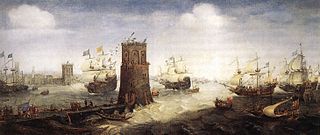
The Fifth Crusade (1217–1221) was a campaign in a series of Crusades by Western Europeans to reacquire Jerusalem and the rest of the Holy Land by first conquering Egypt, ruled by the powerful Ayyubid sultanate, led by al-Adil, brother of Saladin.

The Seventh Crusade (1248–1254) was the first of the two Crusades led by Louis IX of France. Also known as the Crusade of Louis IX to the Holy Land, it aimed to reclaim the Holy Land by attacking Egypt, the main seat of Muslim power in the Near East. The Crusade was conducted in response to setbacks in the Kingdom of Jerusalem, beginning with the loss of the Holy City in 1244, and was preached by Innocent IV in conjunction with a crusade against emperor Frederick II, Baltic rebellions and Mongol incursions. After initial success, the crusade ended in defeat, with most of the army – including the king – captured by the Muslims.

The Battle of Montgisard was fought between the Kingdom of Jerusalem and the Ayyubid Dynasty on 25 November 1177 at Montgisard, in the Levant between Ramla and Yibna. The 16-year-old Baldwin IV of Jerusalem, severely afflicted by leprosy, led outnumbered Christian forces against Saladin's troops in what became one of the most notable engagements of the Crusades. The Muslim Army was quickly routed and pursued for twelve miles. Saladin fled back to Cairo, reaching the city on 8 December, with only a tenth of his army. Muslim historians considered Saladin's defeat to be so severe that it was only redeemed by his victory ten years later at the battles of Cresson and Hattin and the Siege of Jerusalem in 1187. Saladin did defeat Baldwin IV in the Battle of Marj Ayyun and the Siege of Jacob’s Ford in 1179, only to be defeated by Baldwin again at the Battle of Belvoir Castle in 1182 and the Siege of Kerak in 1183.
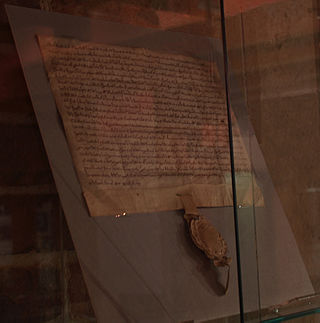
Sir William Longespée was an English knight and crusader, the son of William Longespée and Ela, Countess of Salisbury. His death became of significant importance to the English psyche, having died at the Battle of Mansurah, near Al-Mansurah in Egypt.
John of Ibelin, count of Jaffa and Ascalon, was a noted jurist and the author of the longest legal treatise from the Kingdom of Jerusalem. He was the son of Philip of Ibelin, bailli of the Kingdom of Cyprus, and Alice of Montbéliard, and was the nephew of John of Ibelin, the "Old Lord of Beirut". To distinguish him from his uncle and other members of the Ibelin family named John, he is sometimes called John of Jaffa.
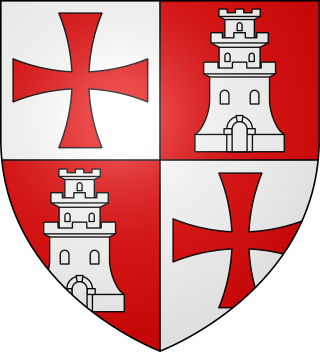
Peire de Montagut was Grand Master of the Knights Templar from 1218 to 1232. He took part in the Fifth Crusade and was against the Sultan of Egypt's conditions for raising the siege of Damietta. He was previously Master of the Crown of Aragon.

William ofChartres(Guillaume de Chartres; c. 1178 – 1218) was the Grand Master of the Knights Templar from 1210 until 26 August 1218.
The Battle of Fariskur was the last major battle of the Seventh Crusade. The battle was fought on 6 April 1250, between the Crusaders led by King Louis IX of France and Egyptian forces led by Turanshah of the Ayyubid dynasty.

The Crusades were a series of religious wars initiated, supported, and sometimes directed by the Christian Latin Church in the medieval period. The best known of these military expeditions are those to the Holy Land in the period between 1095 and 1291 that were intended to reconquer Jerusalem and its surrounding area from Muslim rule. Beginning with the First Crusade, which resulted in the conquest of Jerusalem in 1099, dozens of military campaigns were organised, providing a focal point of European history for centuries. Crusading declined rapidly after the 15th century.

The Battle of Mansurah was fought from 8 to 11 February 1250, between Crusaders led by Louis IX, King of France, and Ayyubid forces led by Sultana Shajar al-Durr, vizier Fakhr ad-Din ibn as-Shaikh, Faris ad-Din Aktai and Baibars al-Bunduqdari. It was fought in present-day Mansoura, Egypt. The Crusader force was enticed into entering the town where it was set upon by the Muslim force. The Crusaders withdrew in disorder to their encampment where they were besieged by the Muslims. The Crusaders broke-out and withdrew to Damietta in early April.

Renaud (Reginald) de Vichiers was the 19th Grand Master of the Knights Templar from 1250 to 1256.

A series of Crusader invasions of Egypt were undertaken by the Kingdom of Jerusalem from 1163 to 1169 to strengthen its position in the Levant by taking advantage of the weakness of the Fatimid Caliphate.

The Battle of Marj Ayyun was a military confrontation fought at Marj Ayyoun near the Litani River in June 1179 between the Kingdom of Jerusalem under Baldwin IV and the Ayyubid armies under the leadership of Saladin. It ended in a decisive victory for the Muslims and is considered the first in the long series of Islamic victories under Saladin against the Christians. However, the Christian King, Baldwin IV of Jerusalem, who was crippled by leprosy, was saved by his bodyguard and narrowly escaped capture.

John Tristan was a French prince of the Capetian dynasty. He was jure uxoris count of Nevers from 1265 and of Auxerre and Tonnerre from 1268. He was also in his own right Count of Valois and Crépy, as an appanages of the crown, from 1268.
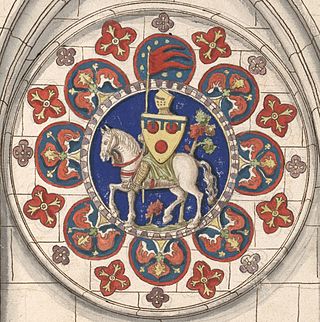
Peter of Courtenay (French: Pierre de Courtenay was a French knight and a member of the Capetian House of Courtenay, a cadet line of the royal House of Capet. From 1239 until his death, he was the ruling Lord of Conches and Mehun-sur-Yèvre.
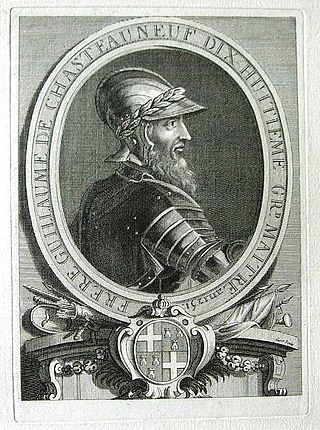
Guillaume de Chateauneuf was the nineteenth Grand Master of the Knights Hospitaller, serving first from 1242–1244 as the successor to Pierre de Vieille-Brioude. He was captured during the Battle of La Forbie in 1244, held hostage in Egypt and ransomed through the Sixth Crusade. During his captivity, his position was filled on an interim basis by Jean de Ronay. De Ronay died in 1250, and de Chateauneuf was released shortly thereafter. He was succeeded by Hugues de Revel.
The battle of Mansurah took place from 26–28 August 1221 near the Egyptian city of Mansurah and was the final battle in the Fifth Crusade (1217–1221). It pitted the Crusader forces under papal legate Pelagius Galvani and John of Brienne, king of Jerusalem, against the Ayyubid forces of the sultan al-Kamil. The result was a decisive victory for the Egyptians and forced the surrender of the Crusaders and their departure from Egypt.
Jean de Ronay was knight of the Order of Saint John of Jerusalem who was appointed Grand Commander of the Knights Hospitaller by the Grand Master Guillaume de Chateauneuf in 1243 or 1244. He served as interim Grand Master of the Knights Hospitaller from 1244 to 1250 during the captivity of de Chateauneuf. He died in battle during the Seventh Crusade.

The history of the Knights Hospitaller in the Levant is concerned with the early years of the Order of the Hospital of St. John of Jerusalem, the Knights Hospitaller, through 1309. The Order was formed in the later part of the eleventh century and played a major role in the Kingdom of Jerusalem, in particular, the Crusades. This lasted until the West was expelled from the Holy Land, with the Order conquering Rhodes in the early fourteenth century. Among the most important internal events of the early years of the kingdom were the foundation of the Military Orders, which included the Hospitallers, the Knights Templar and the Teutonic Order. Unlike the Hospitallers' beginnings as a benevolent organization, the Templars and Teutonic knights began with a military mission. These three major Orders would play a major role in the military activities of the kingdom, sometimes cooperatively, sometimes not. On the battlefield they frequently shared among them the most important tactical roles, the vanguard and rear-guard.















